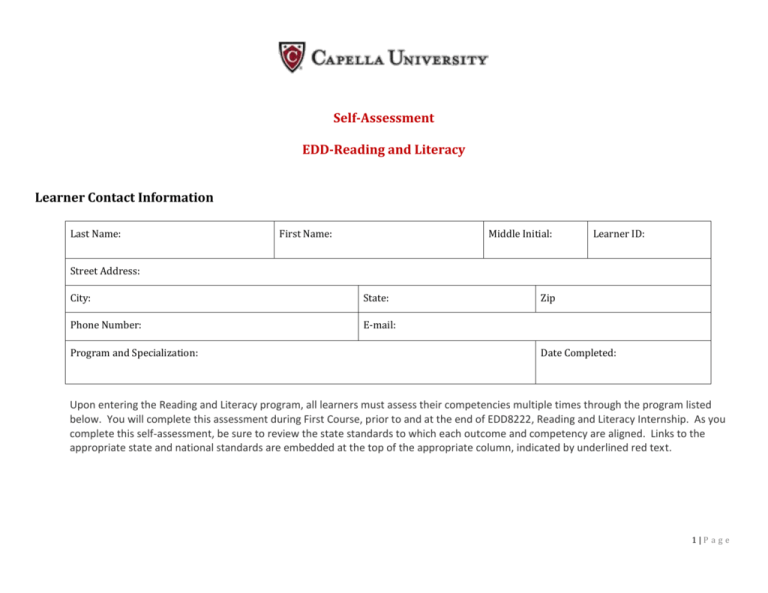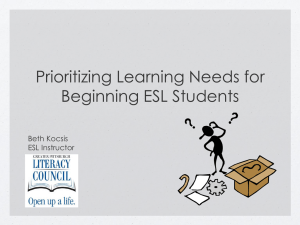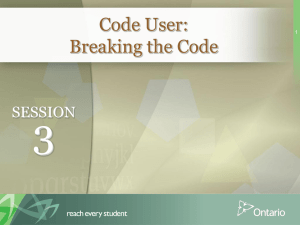EdD – Reading and Literacy Self–Assessment
advertisement

Self-Assessment EDD-Reading and Literacy Learner Contact Information Last Name: First Name: Middle Initial: Learner ID: Street Address: City: State: Phone Number: E-mail: Program and Specialization: Zip Date Completed: Upon entering the Reading and Literacy program, all learners must assess their competencies multiple times through the program listed below. You will complete this assessment during First Course, prior to and at the end of EDD8222, Reading and Literacy Internship. As you complete this self-assessment, be sure to review the state standards to which each outcome and competency are aligned. Links to the appropriate state and national standards are embedded at the top of the appropriate column, indicated by underlined red text. 1|P a g e Submission Please indicate which submission of your three required self-assessments this document will be by placing and “X” in the corresponding box below. First Course Submission Pre-Clinical Practice Post-Clinical Practice Submission Instructions* 1. If this is the Pre-Clinical Practice submission, this document must be submitted with your clinical practice application by emailing to Efaxdocmgmt@capella.edu or faxing to 1.888.227.8492. 2. If this is your First Course or Post-Clinical Practice submission, submit the self-assessment within your courseroom as an assignment. *Reminder: All three versions of the self-assessment are required artifacts in your e-portfolio. Directions Complete this document for each of the specialization competencies (second column), rate yourself by indicating the appropriate level of competency. Include a brief narrative explanation in the space provided. 3= Distinguished (Learner demonstrates extensive experience and expertise) 2= Proficient (Learner demonstrates some experience and average expertise) 1= Basic (Learner demonstrates limited experience and expertise) 0= Non-Performance (Learner demonstrates zero experience or expertise) 2|P a g e Reading and Literacy Specialization Outcomes Reading and Literacy Specialization Competencies Minnesota Standards for Teachers of Reading (Rule 8710.4725) 1. Instruct through the use of reading and literacy strategies for student achievement. 1. Develop children’s fluency and automaticity in both oral and silent reading. A4 2. Develop comprehension and appreciation in children of a wide range of children’s, adolescent, and adult narratives. 3. Develop children’s comprehension and learning from expository texts such as articles, essays, textbooks, technical manuals, and original documents found in a variety of disciplines and content areas in and out of school. A5 4. Develop emergent treading skills in children such as phonemic awareness, alphabet recognition, and understanding that printed words convey meaning. A1 Learner Self Assessment of level of competency (using 0-3 scale outlined in the Directions section) (Qualitative) Narrative for experience and expertise A6 Continue on the next page 3|P a g e Reading and Literacy Specialization Outcomes Reading and Literacy Specialization Competencies Minnesota Standards for Teachers of Reading (Rule 8710.4725) 5. Develop word recognition skills in children including phonics, blending, structural analysis, and contextual analysis. 6. Develop in children an initial sight vocabulary and an increasingly larger and more complex vocabulary; mastering word-learning strategies such as the use of context and structural analysis, and developing word consciousness. 7. Develop comprehension strategies such as adjusting reading approach, activating background knowledge, summarizing, generating questions, constructing mental representations, and self-monitoring. 8. Develop children’s understanding, remembering, valuing, and using information gained from reading in and outside of school. A2 Learner Self Assessment of level of competency (using 0-3 scale outlined in the Directions section) (Qualitative) Narrative for experience and expertise A3 A7 A8 Continue on the next page 4|P a g e Reading and Literacy Specialization Outcomes 2. Integrate reading and literacy assessments to improve student achievement. Reading and Literacy Specialization Competencies Minnesota Standards for Teachers of Reading (Rule 8710.4725) 9. Develop in children higher-order thinking skills and behaviors such as thinking independently, withholding, judgment, recognizing point of view and bias, and considering multiple solutions. 10. Incorporate writing strategies and practices to advance reading development and learning from text. 11. Encourage reading widely and independently for learning, understanding, and enjoyment. 12. Apply instructional and informational technologies and electronic resources to support literacy. 1. Use best practice in individual and group reading assessment. A9 Learner Self Assessment of level of competency (using 0-3 scale outlined in the Directions section) (Qualitative) Narrative for experience and expertise A10 A11 C8 B1 and B5 Continue on the next page 5|P a g e Reading and Literacy Specialization Outcomes Reading and Literacy Specialization Competencies Minnesota Standards for Teachers of Reading (Rule 8710.4725) 3. Plan and implement a comprehensive reading and literacy curriculum based on informed analysis of data. 1. Select best practice strategies, materials, and instruction for students with a wide range of reading background and skills ranging from students in need of early intervention or remediation to students with exceptionally advanced reading skills and needs. C1 and B2 2. Analyze appropriate educational principles relevant to the physical, social, emotional, moral, and cognitive development of children, preadolescents, and adolescents. B3 3. Use sound principles of analysis and evaluation of individual and group reading assessment data. C3 4. Use sound principles in assessing, analyzing, and evaluating reading curriculum. C5 Learner Self Assessment of level of competency (using 0-3 scale outlined in the Directions section) (Qualitative) Narrative for experience and expertise Continue on the next page 6|P a g e Reading and Literacy Specialization Outcomes Reading and Literacy Specialization Competencies Minnesota Standards for Teachers of Reading (Rule 8710.4725) 4. Integrate research and theory in practice. 1. Analyze the role and alignment of district, school, and department missions and goals in reading program planning as well as current state and federal legislation as it relates to reading. 2. Apply fiscal, budgetary, and purchasing practices for operating a comprehensive reading program. B4 Learner Self Assessment of level of competency (using 0-3 scale outlined in the Directions section) (Qualitative) Narrative for experience and expertise C2 and C7 Continue on the next page 7|P a g e Reading and Literacy Specialization Outcomes Reading and Literacy Specialization Competencies Minnesota Standards for Teachers of Reading (Rule 8710.4725) 5. Collaborate for the improvement of reading and literacy. 1. Advise and strategize implementing reading curricular and instructional decisions based on informed analysis of date. C6 2. Communicate applied current knowledge and research-based best practices in reading education at the elementary, middle, and high school levels to colleagues and the wider community. C4 3. Develop curriculum, strategies, and materials based on the knowledge that reading is the process of constructing meaning through the interaction of the reader’s existing knowledge, the information suggested by the written language, and the reading context. C9 and C10 Learner Self Assessment of level of competency (using 0-3 scale outlined in the Directions section) (Qualitative) Narrative for experience and expertise Continue on the next page 8|P a g e Reading and Literacy Specialization Outcomes Reading and Literacy Specialization Competencies Minnesota Standards for Teachers of Reading (Rule 8710.4725) Learner Self Assessment of level of competency (using 0-3 scale outlined in the Directions section) (Qualitative) Narrative for experience and expertise 4. Apply the standards of effective practice in teaching students reading through a variety of ongoing clinical experiences with elementary, middle, and high school students within a range of educational programming models. 5. Provide and model instructional strategies to improve student reading across the curriculum. 6. Provide professional development that supports supplementing and improving reading instruction and curriculum. 7. Analyze available resources from professional organizations whose mission is the improvement of literacy. 9|P a g e 10 | P a g e









